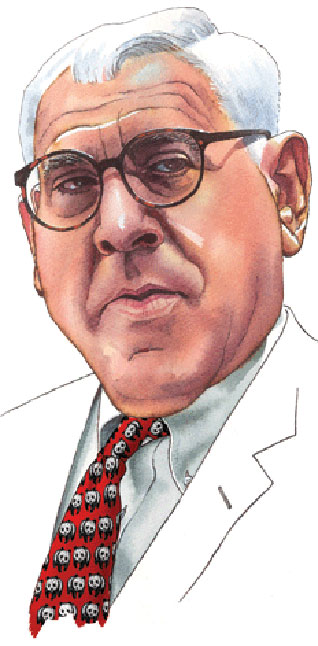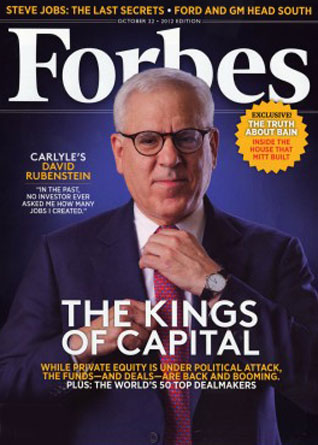Roundtable
What Are Our Uber-Wealthy Doing For the Community?
The Roundtable Open Forum # 130
MICHAEL RUANE
After philanthropist David M. Rubenstein agreed to fund half the cost of fixing the earthquake-damaged Washington Monument in Washington, D.C., USA, he asked National Park Service Director Jonathan B. Jarvis: “What else you got?”
“Well, I have a long list,” Jarvis said he replied.
At the top was the repair of the tattered 200-year-old Arlington House, which serves as the Robert E. Lee Memorial at Arlington National Cemetery. Its condition, Jarvis thought, was embarrassing.
Last winter, on a cold, rainy day, Jarvis gave Rubenstein a tour of the house where the famous Confederate general had lived before the Civil War.
Rubenstein asked for a repair proposal.
“We proposed $12.3 million,” Jarvis said Thursday, July 17, 2014.
He said Rubenstein replied, “Be glad to do that.”
On Thursday, Jarvis stood beside Rubenstein outside the portico of Arlington House and announced that the Bethesda billionaire is donating $12.35 million to rehabilitate the house, grounds and slave quarters.
The majestic Greek Revival home of Lee and his family for 30 years is one of the most beautiful spots in the area. The columned mansion sits high on a hill overlooking the cemetery, the Potomac River and the District.
The money is going to the National Park Foundation, the Park Service’s nonprofit fundraising partner. The Park Service operates Arlington House.
The donation will transform the site and the experience for the 650,000 people who visit each year, Park Service officials said. The house and grounds are to be restored to the way they were in 1860.
New interior lighting will be installed. Work will be done on the damaged foundation. And a state-of-the-art climate-control system will be installed.
Most of the work will happen in 2016. It will require the construction of scaffolding around the house and could require closing the museum and the slave quarters for nearly a year.
“My goal has been for the last couple years to give back to the country some of the good fortune that I’ve had,” Rubenstein said as he stood flanked by Jarvis and Neil Mulholland, president of the foundation.
“Some of that good fortune has been earned in Washington, D.C., and so I’m very interested in helping Washington, D.C., and the Washington area,” he said.
“When [the house is] repaired and restored, it’ll be more attractive for people to see and I think a better indication of what life was like here then,” he said later.
“The goal is to remind people of American history,” he said. “Unfortunately, people know so little about our history . . . If you get a chance to tour this [house] and you think more about history . . . maybe you’ll be inspired to learn more about your country. And that’s really why I try to do this.”
Arlington House is rich in history. It is said to be modeled on the ancient Greek Temple of Hephaestus in Athens.
Built as a tribute to George Washington, it was also the place where, at the start of the Civil War, an anguished Lee decided to leave the U.S. Army and cast his lot with the South.
And over time, it became a centerpiece for the cemetery.
Rubenstein -- co-founder of the Carlyle Group, a global private equity firm -- has a passion for U.S. history and has made major history-themed donations in the past. He is especially interested in George Washington, and this is his third Washington-related donation.
His Washington Monument donation paid $7.5 million of the $15 million in the just-completed repairs required after the 2011 earthquake.
Last year, he paid $14.2 million for a rare copy of the 1640 Bay Psalm Book, said to be the first book printed in what became the United States. He said he planned to put the book on revolving loan to several libraries.
Earlier last year, he gave $10 million to Mount Vernon for a George Washington library.
The imposing Arlington mansion, with its eight columns and grand portico, was built mostly by the slaves of George Washington Parke Custis in three stages between 1802 and 1818.
Most of the house and its columns are made of brick covered with stucco made to look like stone. There is a massive century-old cedar tree in the back yard.
Custis, who had about 60 slaves at Arlington, was the step-grandson of George Washington. He had been raised by Washington at Mount Vernon and was devoted to the nation’s first president.
Custis built Arlington as a salute to Washington, and the home’s dining room still has dishware from Mount Vernon.
Custis’s daughter, Mary Anna, married Lee in the parlor of the home on June 30, 1831, and six of their seven children were born in the house, according to the Park Service.
“It is a noble-looking place, having a portico of stately white columns, which . . . with a background of dark woods, forms a beautiful object in the landscape,” the English novelist Francis M. Trollope wrote in 1832, according to a Park Service report.
Mary Anna Lee inherited the property when her father died in 1857, and her husband, then a highly regarded U.S. Army officer, took over its management and upkeep.
But with the outbreak of the Civil War, Lee resigned from the Army and left Arlington for Richmond on April 22, 1861. His wife left three weeks later.
The Union army quickly occupied the property because of its strategic location.
The cemetery, which is now run by the Army, was created three years later with the huge influx of dead soldiers from the bloody battles of 1864 and bitterness toward Lee over his role in the war.
The cemetery marked the 150th anniversary of its founding last month.
The Lees never lived in the mansion again, although in 1883, after a Supreme Court ruling, the government paid the family $150,000 for seizing the property, Matthew Penrod, a park ranger, said in a recent interview.
He said the settlement was finalized by Lee’s eldest son, Custis, and Abraham Lincoln’s eldest son, Robert, who was then the secretary of war.
In the years after the Civil War, the house went through cycles of decay and repair and for years was used as the home of the cemetery superintendent.
In 1925, Congress authorized restoration of the house, and it was designated a memorial to Lee. The National Park Service took over its management in 1933. The house has been on the National Register of Historic Places since 1966.
THE ROUNDTABLE OPEN FORUM # 130
We have no dearth of our own uber-wealthy -- that is, Sikh billionaires and multi-millionaires.
But have they found the time and the inclination, the passion and the commitment, the wisdom and the foresight, to invest their spare pocket-change back into the community?
We have a long and enviable history and tradition of philanthropy, but it may have got off the rails in recent years when other priorities may have taken over ... to the detriment of the community and of the uber-wealthy themselves.
Why has this happened, if it is at all true? Has it been to the detriment of the community? How?
How can we put things back on track?
We invite your thoughts on this.
[Courtesy: The Washington Post]
July 18, 2014
Conversation about this article
1: Sangat Singh (Kuala Lumpur, Malaysia), July 18, 2014, 7:17 PM.
Most of us who want to be seen doing good, in the final analysis do so only to nourish our egos. Guru Granth Sahib has answers even for the subtlest ego. There are several shabads referring to the 'harchandori' mirage. As an example: Raja Harichandar who was known for his extreme charity, as he was being transported to heaven to reap his just reward, wanted to take a look at the good he had done and got promptly stuck and earned for posterity the name of the 'Harchandori' mirage: "Beholding the phantom city, you have gone astray; how can you now find stability?" [GGS:548.5]
2: Raj (Canada), July 18, 2014, 11:52 PM.
No.. No.. No.. we are more interested in getting our politicians get more rich and rule the world. We should all ask ourselves, when was the last time we donated money to a library, museum or intellectually inclined organization?
3: Jaskaran Kaur (Massachusetts, USA), July 19, 2014, 10:09 AM.
At the heart of our problems is the fact that many of those most privileged amongst us have lost their bearings. It is not the only reason for our complicated challenges today, but certainly one of the main ones. Sad, that those blessed with so much have learnt to become Malik Bhagos. Poverty is not a state one embraces in Sikhi, though it is certainly not viewed as an affliction. Neither is wealth. Actually, Sikhs were and are encouraged by our Gurus to be entrepreneurial and highly successful. The tragedy lies in when many of those who do reach the top forget their raison d'etre.
4: Dr Dalbir Singh (Malaysia), July 20, 2014, 10:59 PM.
I feel we should form a relief council to look after those who suffered in 1984 in Delhi and the Partition of Punjab. And to help Bhai Iqbal Singh of Baru Sahib.
5: Ajay Singh (Rockville, Maryland, USA), July 21, 2014, 9:10 AM.
A few years ago I went to Punjab and I had a little 'spare change' and I wanted to, for lack of a better word, donate it. I discussed it with an elderly uncle and the first thing he said was: Do not, under any circumstances, give money to any gurdwara, even at the Darbar Sahib. I thought that was the most offensive, sad and horrible thing to hear, but I took the advice. Other options that were presented were to give money to someone who can use it to marry a daughter, pay for prosthetic limb(s), etc. I gave it to a lady who was running a shelter for orphaned Sikh girls in Chandigarh. An ordinary dwelling in Chandigarh that housed about a 100 girls, they offered a tour but I did not have the stomach for it. I gave the money without asking too many questions but I did not feel good, instead felt horrible. We as community have given a lot ... a lot of money for Sikhs in Punjab in the 80's and early 90's, that ended up building mansions for some really despicable persons. My point is, what is my community or the extent of it? I don't think I am comfortable in giving or asking someone to give any money to anything in Punjab, no gurdwara in USA and Canada. Instead, invest money in our children. So, the uber rich can start foundations to give scholarships, generous ones, to Sikh students, the criteria should be strict, to Sikhs with a history of community service to the local Sikh community in the form of mentorship, knowledge of gurbani, Sikh history, etc., etc. Start a PAC to fund Sikh politicians, not the Nikki's of this world, but those committed to Sikhi. I will give my 'spare change' -- and more -- for any such foundation, PAC, trust, etc.




